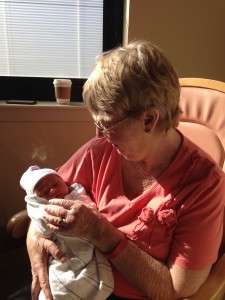
The Birth of a New Grandchild
Today I met my new granddaughter. I held her in my arms and looked into her wise little eyes. It was, as such rare events are, a magical experience, one that will stay with me for a very long time.
But almost as magical was watching her parents as they very competently held their daughter, swaddled her, burped and soothed her. In two days, they had learned her noises, her needs, and her favorite positions. A husband and wife had entered the hospital on Saturday, and by Monday they and their daughter had already become a family. In the two hours I spent with them today, I saw them and the medical staff consult on many topics, but in each case they made their decisions together as a team. They were offered advice and assistance on pain management, breastfeeding, swaddling, burping, treatment of jaundice, and the possible introduction of formula. But the final decisions were made by Mom and Dad. As they told me their story of labor and delivery, I learned that it had been the same ever since they had entered the hospital, including whether or not to choose anesthesia, what their options were, and whether and when to elect surgical assistance. And throughout all those decisions and procedures they had been together.
That Was Then
In November 1972, my first child was born in Washington, D.C.. Standard practice in hospitals then was to bar husbands from labor and delivery, and to require them to comply with rigid visiting hours to see their wives in their rooms and their babies in the nursery down the hall. Rooming-in was sometimes available for extra cost, but even then, babies were returned to the nursery before visitors were allowed to enter their mother’s room. Labor and delivery followed strict protocols including procedures presumed to reduce infection and reduce the length of labor, such as shaving the pubic area, an enema, and a “little cut” or episiotomy to widen the opening of the vagina.
Mothers generally labored alone, usually in a bed, while Dad cooled his heels in a waiting room down the hall. Laboring women were not allowed to eat or drink in case surgery became necessary. During labor, they were given Demerol or morphine for pain, and ether or nitrous oxide for delivery, or be numbed from the waist down with a spinal block. Delivery generally took place with the woman lying on her back with her legs in stirrups, sometimes with her hands in restraints. After birth, her baby would be assessed then whisked away to a centralized nursery where s/he was weighed, measured, poked, pricked, washed thoroughly, treated with stinging silver nitrate eye drops, and placed in a plastic isolette. Mothers were generally not allowed to see their babies or hold them until several hours after birth, by which time the infant would have been fed glucose water or formula to “test” sucking, swallowing, and digestion*.
Thanks in part to these inflexible and lonely labor, birth and postpartum procedures, breastfeeding dropped to its lowest historical level in 1972. Fathers who had been shut out of the birth experience described feeling guilt and shame. Moms often found it difficult to bond with their babies while they were coping with the physical and emotional indignities they had experienced. In some parts of the country, home birth reemerged as an alternative, but since there was little or no official training or oversight, it wasn’t always a safe one.
My husband and I were very lucky that November. Through no real effort of our own, other than reading an article in the Washington Post, I was able to labor at home, birth my daughter in the hospital with no interventions, and we were on our way home within two hours of her birth. The article had been about Dr. Lowell Schwab, who was pioneering this practice at Georgetown University Hospital, which he called in-and-out delivery. Once back home we had the help of the midwife who had coached me during labor, a La Leche League leader who helped me get started nursing, and one another. I had been terrified of giving birth in a hospital and until we met Dr. Schwab I had planned to refuse to leave the house once I went into labor. His enlightened approach to hospital childbirth may have saved my life.
The natural childbirth movement had begun in the late 1960s, but really got off the ground in the 1970s with the publication of several books addressing the link between birthing practices and the parenting experience. Most influential were The Cultural Warping of Childbirth, by Doris Haire; The Experience of Childbirth, by Sheila Kitzinger; Birth Book, by Raven Lang (founder in 1971 of the Santa Cruz Birth Center); Our Bodies, Our Selves, by the Boston Women’s Health Collective; and Immaculate Deception: A New Look at Women and Childbirth in America, by Suzanne Arms.
As these books opened their eyes to new possibilities, parents began to demand changes in hospital practices. They also voted with their feet. The first hospitals to allow fathers in labor and delivery rooms and to offer infant rooming in and reduced medical interventions found themselves becoming very popular. Other hospitals gradually followed suit.
This is Now
What a difference a few decades has made. Now before the birth of their child, parents have many opportunities to educate themselves and prepare themselves to make good choices when the time comes. Parents can avail themselves of modern genetic testing and prenatal assessments, life-saving medical interventions and pain management, yet meet their newborn child in a protective, supportive setting that provides them with an excellent beginning to their lives together.
Anyone who has been watching Call The Midwife on PBS knows that until early in the twentieth century women labored and delivered at home, and until about 1950 birth was very much a family affair. Interventions were minimal, especially among the working and middle class, not just in the UK but in most of the world. Hospitals were expensive, and most mothers gave birth at home or in specialized lying-in hospitals with nurse-midwives in attendance. Mothers and babies were not separated, and the breastfeeding relationship was nurtured and often continued for a year or more. Fathers may not have been at delivery, but they were nearby (usually instructed to boil water to keep them busy), and very much a part of the early life of their child. Even in the US, hospitals were reserved for high risk births until the end of World War II. After that, the medical intervention model took over, and the rest was the history described above.
Now, at least in most communities and at many hospitals in the US, we have something that works both for babies and for families. I couldn’t be more pleased.
*(This historical account was adapted from The Impact of Birthing Practices on Breastfeeding, by Mary Kroeger: 2004).
Readers, what has been your experience with childbirth? What impact has the family childbirth movement had on your life and/or that of your parents, family, or friends? Please share by using the comment form below.
Share this post


